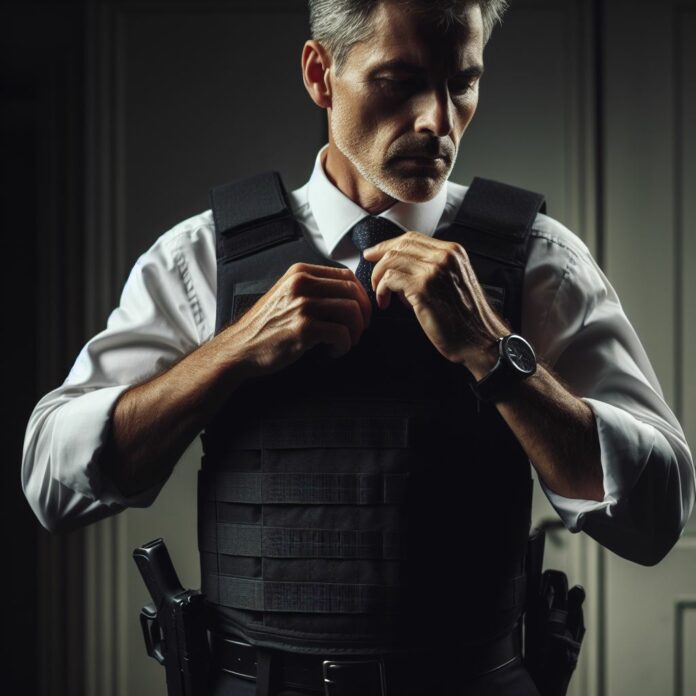Choosing the right size of a bulletproof vest is crucial for ensuring optimal protection and comfort. A bulletproof vest, also known as a ballistic vest, is designed to protect the wearer from projectiles and shrapnel.
Understanding the key considerations and measurements involved in selecting the right size is essential for a proper fit.
Understanding Bulletproof Vests
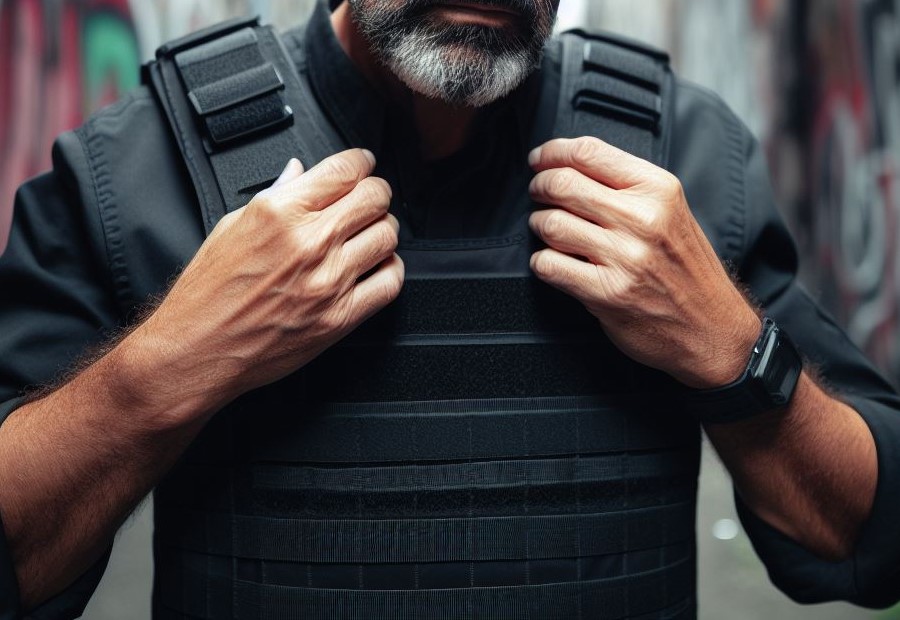
Understanding bulletproof vests can be crucial when it comes to personal safety. These specialized vests are designed to protect the wearer from gunfire and other ballistic threats by using materials like Kevlar or Dyneema.
These materials have the ability to absorb and disperse the impact of bullets, ensuring the wearer’s safety.
Bulletproof vests come in a range of sizes, from small to extra-large, and offer different levels of protection, from Level II to Level IV. It is important to choose the right size to ensure proper coverage and comfort, considering factors such as chest size and height.
Additionally, it is essential to be aware of the limitations of the vest, including its lifespan and the importance of regular inspection and maintenance.
By having a clear understanding of bulletproof vests, individuals can make informed decisions regarding their personal safety and protection.
Importance of Choosing the Right Size of a Bulletproof Vest
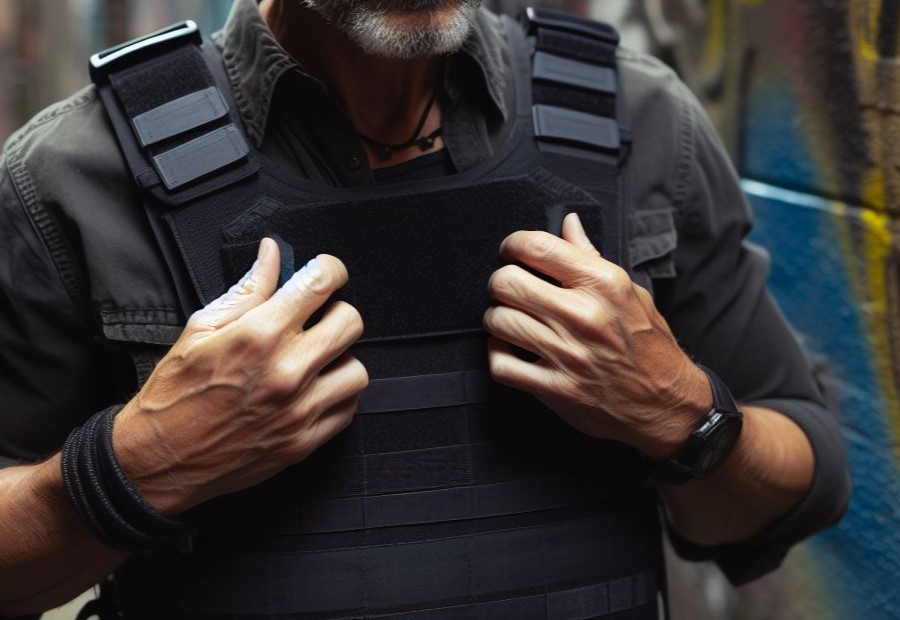
Choosing the right size of a bulletproof vest is of utmost importance for optimal protection. Ensuring that your vest fits properly is crucial as wearing an ill-fitting one can jeopardize your safety and leave vulnerable areas exposed.
It is essential to note that manufacturers offer bulletproof vests in a variety of sizes to accommodate different body types. By selecting the correct size, you guarantee that the vest adequately covers your vital organs and fits snugly against your body.
Conversely, an improperly sized vest can restrict your movements and hinder your ability to react swiftly in hazardous situations. To find the appropriate size, use a measuring tape to measure your chest and waist, referring to the manufacturer’s sizing chart provided.
It is vital to adhere to these guidelines to ensure a proper fit. Always remember that a well-fitting vest not only enhances your safety but also provides the necessary comfort and maneuverability.
Therefore, never underestimate the significance of choosing the right size for your bulletproof vest.
Measuring for the Right Size
When it comes to choosing the right size of a bulletproof vest, getting accurate measurements is the key.
Chest Measurement
When selecting the perfect size of a bulletproof vest, accurately measuring your chest is of utmost importance. Follow these steps to ascertain your chest measurement:
- Stand up straight with your arms relaxed at your sides.
- Wrap a measuring tape around the fullest part of your chest, just below your armpits.
- Make sure the tape is snug but not excessively tight, and ensure it is parallel to the ground.
- Document the measurement in inches or centimeters.
- Consult the size chart provided by the bulletproof vest manufacturer to determine the suitable size based on your chest measurement.
Pro-tip: When measuring your chest, it’s vital to wear lightweight clothing or none at all for the most accurate measurement.
Waist Measurement
When determining the correct size for a bulletproof vest, it is crucial to have an accurate waist measurement. Follow these steps for an accurate waist measurement:
- Using a measuring tape, stand up straight with your feet shoulder-width apart.
- Wrap the measuring tape around your waist at its narrowest point, which is typically around your belly button.
- Pull the measuring tape snugly, but not too tight, around your waist.
- Make sure the measuring tape is parallel to the floor and not twisted.
- Take note of the waist measurement in inches or centimeters.
Based on the waist measurement, you can then refer to the size chart provided by the manufacturer to determine the appropriate size of the bulletproof vest.
Remember to measure your waist accurately and consult the size chart provided by the manufacturer to choose the correct size for your body type.
Shoulder Measurement
The proper fitting and comfort of a bulletproof vest depend on considering the shoulder measurement. This measurement is crucial for ensuring optimal protection and mobility. To determine the correct shoulder measurement, follow these steps:
1. Stand upright with your arms at your sides.
2. Use a flexible measuring tape to measure from the edge of one shoulder to the edge of the other shoulder across the back.
3. Record the measurement in inches or centimeters.
Torso Length Measurement
To make sure that a bulletproof vest fits properly, it is crucial to accurately measure the torso length. In order to determine the torso length, follow these steps:
- Stand erect with your back against a wall.
- Place a measuring tape vertically against the wall, starting from the base of your neck.
- Extend the tape down to the point where your torso ends, typically at the height of your hip bones.
- Ensure that the measuring tape is parallel to the floor and not slanted.
- Take note of the measurement on the tape to ascertain your torso length.
Measuring the torso length plays a vital role in selecting the appropriate size of a bulletproof vest.
It aids in determining the length of the vest that will offer sufficient protection while allowing free movement and avoiding any exposed vulnerable areas.
It is essential to abide by the manufacturer’s sizing guidelines and take into account your body shape and type when choosing a bulletproof vest.
Fitting and Adjusting the Bulletproof Vest
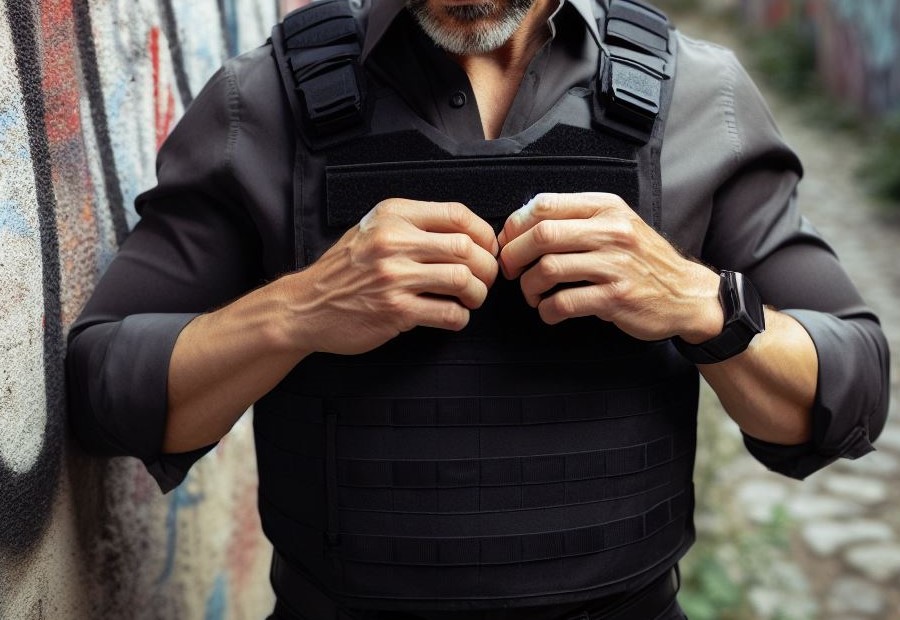
Fitting and adjusting the bulletproof vest is crucial for ensuring proper protection and comfort. Here are the steps to follow:
- Measure accurately: Use a measuring tape to determine your chest size and waist size.
- Select the right size: Refer to the manufacturer’s size chart and choose the vest size that aligns with your measurements.
- Put on the vest: Loosen all the straps and put on the vest over your shirt or any other clothing.
- Tighten the shoulder straps: Pull the shoulder straps evenly on both sides and tighten them to ensure a snug fit.
- Adjust the waist straps: Fasten the waist straps, making sure the vest is secure but not too tight.
- Check mobility: Move your arms and shoulders to ensure a full range of motion while wearing the vest.
- Recheck the fit: Stand straight and check if the vest sits properly on your chest and doesn’t restrict your breathing.
- Make necessary adjustments: If the vest feels uncomfortable or ill-fitting, readjust the straps until you achieve a comfortable fit.
Pro-tip: It’s important to regularly reassess the fit of your bulletproof vest, especially if you gain or lose weight. Proper fitting and adjustment maximize the effectiveness of the vest and ensure your safety in potentially dangerous situations.
Testing the Fit
Range of Motion Test
The range of motion test is imperative in assessing the proper fit and functionality of a bulletproof vest.
- Firstly, don the bulletproof vest and securely fasten all straps and closures.
- Stand upright and gradually raise your arms in front of you, ensuring they remain parallel to the ground. Take note of any limitations or discomfort experienced during this movement.
- Next, attempt to lift your arms above your head, fully extending them. Pay close attention to any restrictions or tightness around the shoulder area.
- Lower your arms and then try extending them out to the sides, once again keeping them parallel to the ground. Evaluate if there are any obstructions or constrictions.
- Bend forward at the waist, mimicking the action of picking something up from the ground. Assess whether the vest allows for comfortable and unhindered performance of this action.
- Complete the test by twisting your torso from left to right, confirming that the vest does not impede your movement or cause discomfort.
The range of motion test is critical as it determines whether the bulletproof vest permits fluid and unrestricted movement, which is crucial for optimal maneuverability and operational effectiveness.
Flexibility Test
The flexibility test is a crucial step in determining the appropriate size for a bulletproof vest. Here is a comprehensive list of steps to conduct the flexibility test:
- Don the bulletproof vest and ensure it is properly secured.
- Commence by performing basic stretching exercises, such as reaching for the sky or touching your toes, to assess the range of motion.
- Gently bend your torso from side to side and forward and backward to evaluate the flexibility of the vest.
- Extend your arms in various directions, mimicking reaching for an object, to determine if the vest limits your movement.
- Rotate your upper body from side to side to examine if the vest obstructs your rotational movement.
- Execute several squats or lunges to assess the flexibility of the vest when moving your legs.
By conducting the flexibility test, you can ensure that the bulletproof vest allows for comfortable and unrestricted movement.
It is vital to have a vest that does not hinder your agility or range of motion, as this could potentially impede your effectiveness in critical situations.
In 1965, Stephanie Kwolek invented Kevlar, a resilient and pliable fiber extensively used in bulletproof vests. Her groundbreaking discovery transformed the realm of protective gear and has saved numerous lives since its inception.
The flexibility test stands as a crucial component in the process of fitting a vest, guaranteeing that individuals can move effortlessly while maintaining optimal safety and protection.
Kwolek’s invention continues to shape the advancement of bulletproof vests and other protective equipment in today’s world.
Comfort Test
The comfort test is an essential aspect to consider when choosing a bulletproof vest. It ensures that the wearer can comfortably wear the vest for extended periods without experiencing discomfort or restricted movement.
- The vest should fit snugly but not too tight, allowing for flexibility and ease of movement.
- The shoulder straps should be adjustable to provide a customized fit and distribute the weight evenly.
- The vest should not rub against or chafe the skin, causing irritation or discomfort.
- The fabric should be breathable and moisture-wicking to prevent excessive sweating and discomfort.
- The vest should not restrict range of motion in the arms, allowing for easy movement and operation of firearms or other equipment.
- The weight of the vest should be evenly distributed across the body to prevent strain or fatigue.
- The vest should not dig into the torso or restrict breathing, ensuring comfort during wear.
- Proper padding and cushioning should be present in areas that come into direct contact with the body, such as the shoulders and chest.
- The vest should not shift or move around during physical activity, maintaining a secure and comfortable fit.
By conducting a thorough comfort test, individuals can ensure that the chosen bulletproof vest will provide the necessary protection without sacrificing comfort or mobility.
Factors to Consider When Choosing a Bulletproof Vest
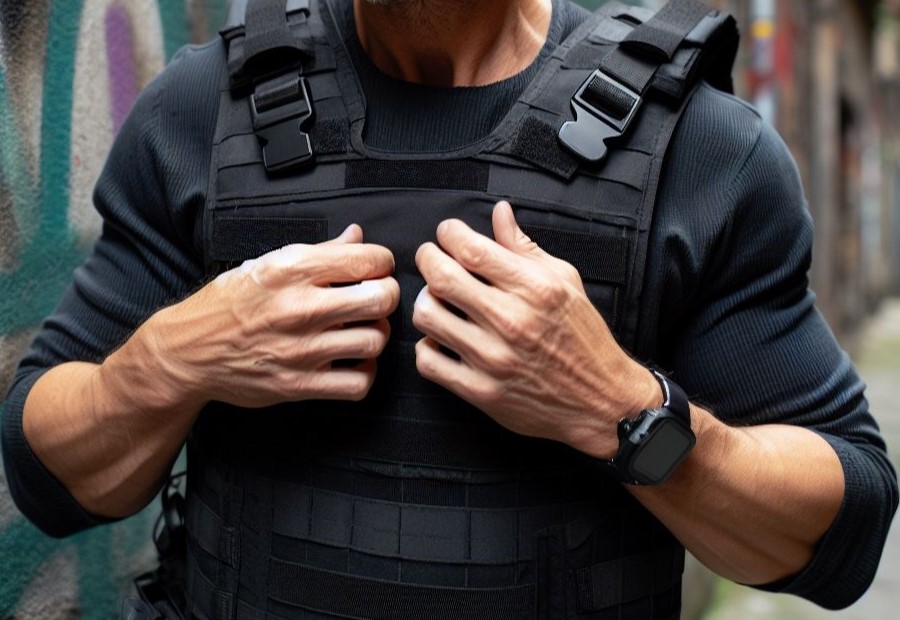
When it comes to choosing the right bulletproof vest, there are several crucial factors to consider. From the level of threat you may face to the materials and construction of the vest, each aspect plays a vital role in your safety.
Additionally, you’ll want to think about concealability and versatility for your specific needs. By understanding these factors, you can make an informed decision that provides you with enhanced protection and peace of mind.
Threat Level
The threat level refers to the level of protection a bulletproof vest offers against different types of threats.
- Understanding different threat levels: Bulletproof vests are categorized into different levels based on the amount of force they can withstand. Level IIA vests offer protection against low-velocity handgun rounds, while Level IIIA vests provide protection against higher-velocity handgun rounds and some types of shotgun rounds. Level III and IV vests provide protection against rifle rounds and armor-piercing bullets.
- Considering the level of risk: When choosing a bulletproof vest, it is important to assess the level of risk you may encounter. Factors such as your occupation, location, and potential threats should be considered to determine the appropriate threat level.
- Matching the threat level to your needs: Select a bulletproof vest that matches the threat level you are likely to face. For example, if you are a law enforcement officer in a high-crime area, a Level IIIA vest may be suitable. However, if you are a civilian in a relatively safe environment, a Level II vest may be sufficient.
- Customizing the threat level: Some bulletproof vests allow for additional panels or inserts to enhance the protection level. This flexibility allows you to adapt the vest to different situations where the threat level may vary.
Material and Construction
The material and construction of a bulletproof vest are crucial in determining its effectiveness. Different materials and construction methods offer varying levels of protection and durability.
Some common materials used are nylon, Kevlar, and Spectra. Nylon vests are typically stitched for increased strength, while Kevlar vests are laminated to provide excellent protection against bullets.
Spectra vests utilize a woven construction for optimal flexibility and resistance. It is important to choose a vest that is made from high-quality materials and has a sturdy construction to ensure optimal safety in dangerous situations.
Concealability and Versatility
Concealability and versatility are two crucial factors to consider when selecting a bulletproof vest. The ability to easily conceal the vest ensures discreet protection without attracting attention or compromising safety.
This is especially important for individuals who require covert protection in situations where a visible vest may not be practical.
Furthermore, the vest should also offer versatility, allowing for flexibility in usage and adaptability to various situations.
It should be able to accommodate different accessories or attachments, such as pouches or modular panels, so that the user can customize it according to their specific needs.
Additionally, the vest should be comfortable to wear with different types of clothing, seamlessly integrating into everyday wear or specific work attire.
In summary, when choosing a bulletproof vest, it is essential to prioritize both concealability and versatility to ensure optimal protection and convenience in any given situation.
Frequently Asked Questions
How do I choose the right size of a concealable bulletproof vest?
When choosing a concealable bulletproof vest, it is important to consider the size range offered by the manufacturer.
Measure the circumference of your abdomen at the navel using a tape measure and refer to the manufacturer’s sizing chart.
If you are between sizes, it is recommended to choose the smaller size for easier concealment, but keep in mind that it may leave a 1-inch gap on each side without protection. The larger size may overlap and be more difficult to conceal.
Does a larger size provide better protection with higher NIJ levels?
No, the size of the vest does not determine the level of protection. The NIJ levels indicate the ballistic resistance of the vest, and these levels are the same regardless of the size.
It is crucial to choose the right size to ensure the vest fits properly and covers the intended area of protection.
Can I use my dress shirt size as a reference for choosing a bulletproof vest?
No, the size of a bulletproof vest is not determined by dress shirt size. It is recommended to follow the manufacturer’s sizing chart and take accurate measurements of your midsection using a tape measure.
Taking measurements ensures a proper fit and maximum protection.
Is an ill-fitting vest less effective in providing protection?
Yes, an ill-fitting vest can compromise its effectiveness in providing protection. A vest that is too short may leave vital organs unprotected, while a vest that is too long can be uncomfortable and ride up during action.
It is important to choose the right size and properly adjust the vest using Velcro flaps or shoulder straps for a snug and secure fit.
Can females wear male body armor or vice versa?
It is recommended for females to wear female-specific body armor, as it is designed to accommodate the unique shape and proportions of the female body.
Wearing male body armor may result in an ill-fitting vest and may not provide optimal protection or comfort. Similarly, males should choose male-specific body armor for the best fit and performance.
Can a bulletproof vest be worn by high school students?
The use of bulletproof vests by high school students may vary based on local laws, regulations, and school policies. It is important to check with the school administration and local authorities to determine if wearing a bulletproof vest is permitted.

